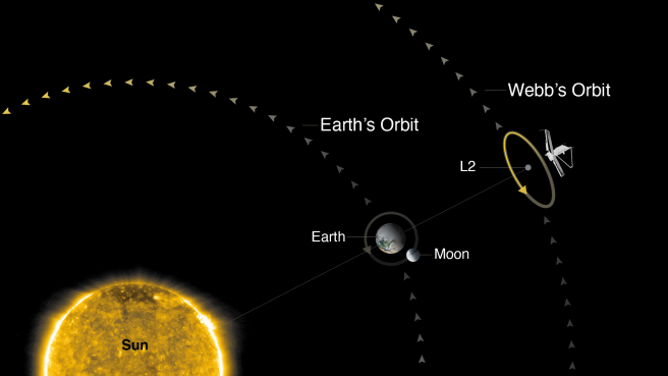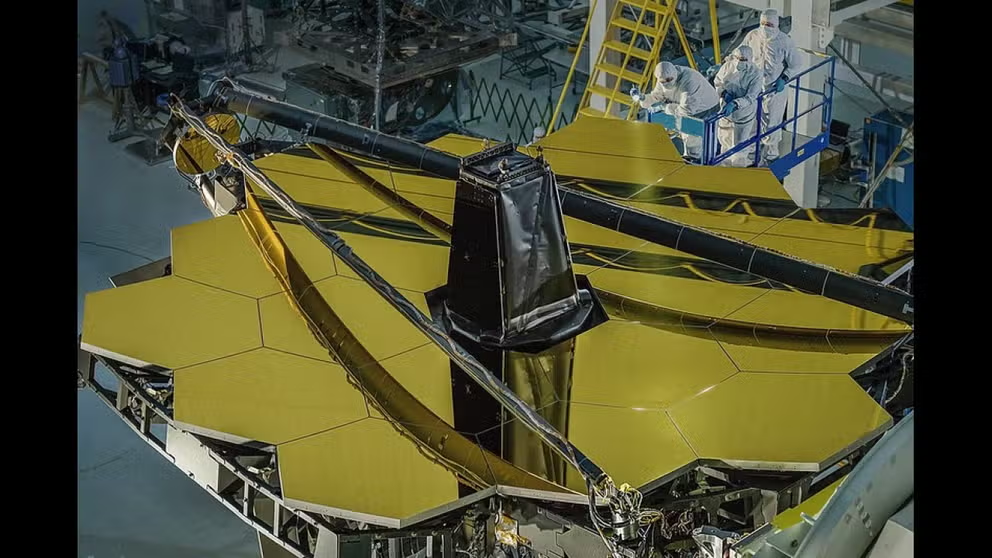1 million miles from Earth, James Webb telescope arrives home
After a month of spaceflight, the telescope arrives at its final orbit 1 million miles from Earth
About a month after launching on Christmas morning, NASA's James Webb Space Telescope has arrived at its final destination in space, 1 million miles from Earth.
Unlike the Hubble Space Telescope, which orbits Earth about 300 miles above the planet, Webb will orbit the sun in line with Earth as it moves around the sun. This allows the $10-billion telescope to operate 24 hours a day with direct contact with Earth.

Webb will operate at the second Lagrange point in space. (Image: NASA)
NASA said Webb fired its thrusters at 2 p.m Monday for nearly five minutes to complete its final maneuver in space to reach the second Lagrange point, or L2, between the sun and Earth. This is where the most powerful telescope ever built will look back at the very first galaxies.
"Webb is officially on station at its L2 orbit," Keith Parrish, NASA's Webb commissioner manager, said in a call with reporters Monday.
The final move in space happened at 3.6 mph, a slow speed that would keep Webb from overshooting and missing the "halo" orbit within L2 that it will need to maintain.
NASA astrophysicist Jane Rigby, working on the Webb science mission, described the halo orbit as if the spacecraft was on a Pringle's potato chip.
"It's the middle of the Pringle's potato chip. It's a semi-stable orbit in our solar system," Rigby said, adding Webb will remain in the middle of the potato chip, inching up the side but never going over the edge.
Since launching from the European Space Port in French Guiana, the telescope has been traveling to L2 and along the way, slowly unfolding the massive mirrors and sunshield that were folded up for liftoff. Earlier this month, the 21-foot, gold-coated primary mirror successfully opened its final six mirrors, completing the deployment process.
JAMES WEBB SPACE TELESCOPE'S GIANT GOLDEN MIRROR OPENS, COMPLETING DEPLOYMENT IN SPACE
Over the next three months, Webb's 18 primary mirror segments must be positioned. Each of the 18 hexagonal mirrors will be aligned to work together. The mirrors will be carefully moved, and each change could be smaller than a strand of human hair.
The first photos sent back by Webb will be "very, very blurry" until the mirrors are correctly aligned, according to Lee Feinberg, Webb's Optical Telescope Element Manager at NASA.
James Webb Space Telescope: By the numbers
James Webb Space Telescope, the most powerful space observatory ever built, is about to begin its mission.
After the telescope is calibrated and tested, it can begin science observation which is expected to start this summer. The first year of Webb's observations has already been determined.
Dr. Amber Straughn, a NASA astrophysicist, working on Webb, explained how observation goals are decided for the telescope. Webb is an international mission between NASA and Canadian and European space agencies, but the astronomy community worldwide will benefit from the telescope.
JAMES WEBB: THE MOST POWERFUL SPACE TELESCOPE BY THE NUMBERS
Once a year, astronomers will work together to write proposals to use the telescope. Another group of astronomers will review the ideas and make the final selection. The process is anonymous to keep the choices fair.
"At the end of the day, the best ideas get prioritized," Straughn said.
In the first year of operations, Webb will look at planets within our solar system and the first galaxies.
Mission managers believe that because Webb's launch trajectory saved the spacecraft enough fuel, it will operate beyond its original ten-year mission timeline. Parrish said engineers are still "fine-tuning" Webb's new lifespan, but it could be closer to 20 years.
"We're all going to be thrilled," Parrish said of the new extended mission.
